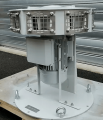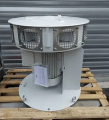Moteurs FOX
| Moteurs FOX | |
 Moteurs FOX's logo, introduced in 2000. | |
| Headquarters | Tourcoing, HDF |
|---|---|
| Founder | François Odoux-Lefebvre
|
| Key people | François Odoux-Lefebvre
|
| Founded | 1949 |
| Products | Outdoor warning sirens
Electric motors
|
| Preceded by | Constructions Électriques du Nord |
FOX Motors (French: Moteurs FOX) is a maintenance and repair company and manufacturer of electric motors, based in Tourcoing, HDF. Founded in 1949 as an offshoot of Northern Electrical Constructions (French: Constructions Électriques du Nord; abbreviated CEN), they are well known for the PAKITA, a brand of outdoor warning siren which has been produced at least since 1964 at the earliest, and their simple design and ruggedness have made them one of the most common sirens in France's nationwide siren system.
History
In the 1940s, François Odoux-Lefebvre, CEO of CEN in Tourcoing, France, sought to expand the reach of individual controls for small machines. CEN, established in 1897, had been a longstanding manufacturer of electrical machinery. However, at the time, many small machines were still controlled by pulley devices and belt transmissions. Seeing an opportunity to innovate, Odoux-Lefebvre founded FOX Motors on April 1, 1949, to complement CEN's production by focusing on fractional horsepower motors. FOX Motors initially specialized in manufacturing small fractional motors (0.1 to 1 hp) used in various industrial applications, such as mechanical, textile, and agricultural machinery.
These motors also found use in household appliances, notably in the washing machines that were becoming increasingly popular in the post-war era. The company grew quickly, with the workforce increasing to 40 employees, ⅓rd of whom participated in evening classes to earn diplomas in electrical coil winding, mechanical turning, and fitting. By 1956, FOX Motors had shifted its focus toward refining its product line, introducing a new series of electric motors, particularly the AS series (Armored closed motors with blown wings and external fans). During the late 1950s, the company pioneered a revolutionary aluminum foundry process for producing short-break circuit rotors and convection stator frames, significantly enhancing the performance of their motors.
Notably, FOX Motors became the first company in France to manufacture cooling turbines and fans using Rylsan in 1958/1959. On September 1, 1959, FOX Motors transitioned to a Société Anonyme (S.A.), further expanding its production capabilities to 4 hp motors. This expansion allowed the company to serve a wider range of industries, with applications in geared motors, fans, pumps, mixers, and sirens. Around this time, François Odoux’s sons joined the leadership of the company, helping guide its continued success. During the 1960s, FOX Motors diversified its operations, repairing and rebuilding motors of small and medium sizes while maintaining its production of standard electric motors. The company also discontinued its rotor and stator sheet cutting activities to streamline its manufacturing processes for small motors.
In 1964, FOX Motors revived its research and production of air raid warning sirens, a field CEN was involved in under François Odoux's direction, starting in 1926. During World War II, CEN had supplied outdoor warning sirens for civil defense in France, and FOX Motors sought to build on this legacy. 2 new siren models, MONICA and PAKITA, were developed and named after classical music and ballet pieces beloved by the Odoux family. The MONICA sirens, known for their harmonic tones, were ultimately discontinued, while the PAKITA sirens, better suited to civil defense needs, became the flagship product. The PAKITA competed with CEN's own Type NP series, despite Odoux's intention with FOX Motors to not compete with CEN at all. Today, PAKITA sirens remain available and continue to serve in France’s national alert system. In 1968, FOX Motors further improved its manufacturing capabilities, focusing on dynamic balancing of rotating components such as rotors and fans.
On January 1, 1969, the company transitioned to a Société à Responsabilité Limitée (SARL), signaling another phase in its evolution. In more recent years, Gérard D. Odoux, grandson of François Odoux, took over the leadership of FOX Motors, continuing the family legacy. In 2013, Christine Odoux, granddaughter of François Odoux, joined the company to expand its international presence and oversee communication and customer service. 1 of the PAKITA models, the BB PAKITA, was eliminated from the PAKITA lineup by 2020 in favor of the slightly larger and better performing PP PAKITA. Today, FOX Motors is a prominent player in France's of electric motor field, contributing to both industrial and public safety projects. The company's renowned PAKITA sirens have been chosen by the French government for the nationwide SAIP (Alert System and Information of Populations) and are one of the most common sirens in France. Additionally, FOX Motors is one of France's leading developers of new electromechanical technologies, including advanced motors for the automotive industry, driven by innovations in power electronics and variable-frequency alternating currents.
Products
MONICA
MONICA is a brand of outdoor warning siren introduced in 1964 that was formerly produced by FOX Motors for a limited time, before being discontinued in favor of the PAKITA, which was apparently better suited for civil defense. It is unknown what exactly MONICA sirens looked like, due to their likely lack of popularity and limited production run. The sirens likely shared a similar design to the PAKITA, albeit with (most likely) a different port ratio which would produce a harmonic tone. Very little is known about MONICA sirens beyond what Moteurs has already said about them.
PAKITA
BB PAKITA

The BB PAKITA is the smallest siren in the PAKITA lineup. The BB PAKITA consists of a 12-port rotor and stator constructed out of aluminum, with an optional mesh screen preventing debris from entering. The siren is driven by a small 50/60 Hz 0.55 kW (0.75 hp) 1 (220/230 V) or 3 ph (380/400 V) motor located below the stator, which spins the rotor at around 2900 rpm. A rain shield with a conical center is located above the rotor and protects the siren from the elements, while a flat circular base below the motor allows the siren to be bolted down to a flat surface, with eyebolts on each corner of the base for ease of installation. A larger, elevated base was also available for the BB PAKITA upon request. The siren weighs around 20 kg (44 lbs). FOX Motors rated the BB PAKITA's output at 98 dB @ 10 m (32.8 ft).
PP PAKITA

The PP PAKITA is one of the smallest sirens in the PAKITA lineup. An extremely simple siren, the PP PAKITA consists of a 12-port rotor and stator constructed out of aluminum, with an optional mesh screen preventing debris from entering. The siren is driven by a small 50/60 Hz 1.1 kW (1.5 hp) 1 (220/230 V) or 3 ph (380/400 V) motor located below the stator, which spins the rotor at around 2850 rpm. A rain shield with a conical center is located above the rotor and protects the siren from the elements, while a flat circular base below the motor allows the siren to be bolted down to a flat surface, with eyebolts on each corner of the base for ease of installation. A larger, elevated base is also available for the PP PAKITA upon request. The siren weighs around 28 kg (61.7 lbs). FOX Motors rates the PP PAKITA's output at 105 dB @ 10 m (32.8 ft).
PP1 PAKITA
The PP1 PAKITA is a 1 ph-only variant of the PP PAKITA, with minimal differences. The PP1 PAKITA is relatively identical to its original counterpart, consisting of a 12-port rotor and stator constructed out of aluminum, with an optional mesh screen preventing debris from entering. The siren is driven by a small 50/60 Hz 1.1 kW (1.5 hp) 1 ph 220/230 V motor located below the stator, which spins the rotor at around 2850 rpm. A rain shield with a conical center is located above the rotor and protects the siren from the elements, while a flat circular base with a mount that attaches to the side of the motor allows the siren to be bolted down to a flat surface, with eyebolts on each corner of the base for ease of installation. A larger, elevated base is also available for the PP1 PAKITA upon request. The siren weighs around 36 kg (79.3 lbs). FOX Motors rates the PP1 PAKITA's output at 105 dB @ 10 m (32.8 ft), similar to the PP PAKITA.
LM PAKITA


The LM PAKITA is the next step up from the PPs, which features a relatively similar design. The siren consists of an 8-port rotor and stator constructed out of aluminum, with mesh screens bolted above each port to prevent debris from entering. 8 stainless/galvanized steel horns with mesh screens installed to prevent debris from entering attached to each stator port are available to order with the siren, which likely significantly improves its audible range; horned units are presumably named LM3P PAKITAs. The "3G" and "3P" nomenclature was likely carried over from CEN's Type NS sirens, of which the PAKITA lineup was inspired by. The horns are offset with the angle of the ports, which is typical for most French sirens produced post-WWII.
The LM PAKITA is driven by a 50/60 Hz 2.2 kW (3 hp) 3 ph 220/230 V or 380/400 V motor located below the stator, which spins the rotor at around 2850 rpm. The LM PAKITA comes with either a 1 ph standard motor or a 3 ph ATEX explosion-proof motor upon request, with units equipped with a 1 ph motor presumably being named LM1 PAKITAs and units with ATEX motors presumably being named LMA PAKITAs. A rain shield with a conical center is located above the rotor and protects the siren from the elements, while a flat circular base below the motor allows the siren to be bolted down to a flat surface, with eyebolts on each corner of the base for ease of installation. A larger, elevated base is also available for the LM PAKITA upon request. Units with ATEX or 1 ph motors' bases come equipped with stands that attach to the side of the motor. The siren weighs around 59 kg (130 lbs). FOX Motors rates the LM PAKITA's output at 115 dB @ 10 m (32.8 ft).
LCi PAKITA

The LCi PAKITA is one of the most popular PAKITA sirens, consisting of an 8-port rotor and stator constructed out of aluminum, with mesh screens bolted above each port to prevent debris from entering. 8 stainless/galvanized steel horns with mesh screens installed to prevent debris from entering attached to each stator port are available to order with the siren, which likely significantly improves its audible range; units without horns are referred to as LCi3G PAKITAs, while units with them are named LCi3P PAKITAs. The "3G" and "3P" nomenclature was likely carried over from CEN's Type NS sirens, of which the PAKITA lineup was inspired by. The horns are offset with the angle of the ports, which is typical for most French sirens produced post-WWII.
The LM PAKITA is driven by a 50/60 Hz 4 kW (6 hp) 3 ph 220/230 or 380/400 V motor located below the stator, which spins the rotor at around 2750 rpm. Unlike most other sirens in the series, the LCi PAKITA's motor is above the stator rather than below it; this reverses the direction the rotor spins, now rotating clockwise instead of anticlockwise. A small circular plate bolted to the top of the motor protects it from the elements. A cylindrical base below the stator allows the siren to be bolted down to a flat surface, with eyebolts on each corner of the base for ease of installation. A larger, elevated base is also available for the LCi PAKITA upon request. The siren weighs around 90 kg (198.4 lbs). FOX Motors rates the LCi PAKITA's output at 120 dB @ 10 m (32.8 ft).
DS PAKITA

The DS PAKITA (also sometimes called the LC PAKITA) is easily the most popular PAKITA siren, making up for most PAKITA installations in total. The siren consists of an 8-port rotor and stator constructed out of aluminum, with mesh screens bolted above each port to prevent debris from entering the siren. 8 stainless/galvanized steel horns with mesh screens installed to prevent debris from entering attached to each stator port are available to order with the siren, which likely significantly improves its audible range; units without horns are referred to as DS3Gs, while units with them are named DS3P PAKITAs. The "3G" and "3P" nomenclature was likely carried over from CEN's Type NS sirens, of which the PAKITA lineup was inspired by. The horns are offset with the angle of the ports, which is typical for most French sirens produced post-WWII.
The LM PAKITA is driven by a 50/60 Hz 9 kW (12 hp) 3 ph 220/230 or 380/400 V motor located below the stator, which spins the rotor at around 2850 rpm. The DS3 PAKITA comes with a 3 ph ATEX explosion-proof motor upon request; ATEX motor units without horns are referred to as DS3AG PAKITAs, while units with them are named DS3AP PAKITAs. A rain shield with a conical center is located above the rotor and protects the siren from the elements, while a flat circular base below the motor allows the siren to be bolted down to a flat surface, with eyebolts on each corner of the base for ease of installation. A larger, elevated base is also an option for the DS PAKITA. Units equipped with ATEX motors have small stands mounted to the base of the siren which attach to the side of the motor. The siren weighs around 135 kg (297.6 lbs). FOX Motors rates the DS3 PAKITA's output at 130 dB @ 10 m (32.8 ft).
Gallery
LM PAKITA
-
An LMA PAKITA unit. Image courtesy of Moteurs FOX.
-
An LM1 PAKITA unit. Image courtesy of Moteurs FOX.
-
An LM13P PAKITA unit. Image courtesy of Moteurs FOX.
-
An LMA3P PAKITA and LMA PAKITA unit. Image courtesy of Moteurs FOX.
LCi PAKITA
-
An LCi3P PAKITA unit. Image courtesy of Moteurs FOX.
DS PAKITA
-
A DS3P PAKITA unit. Image courtesy of Moteurs FOX.
-
A DS3AG PAKITA unit. Image courtesy of Moteurs FOX.
-
A DS3AP PAKITA unit. Image courtesy of Moteurs FOX.







